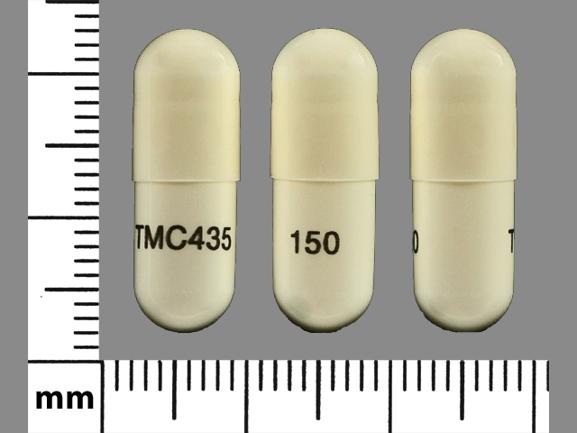Olysio Dosage
Generic name: simeprevir 150mg
Dosage form: capsule
Drug class: Protease inhibitors
Medically reviewed by Drugs.com. Last updated on Nov 10, 2023.
Testing Prior to the Initiation of Therapy
Testing for HBV infection
Test all patients for evidence of current or prior HBV infection by measuring hepatitis B surface antigen (HBsAg) and hepatitis B core antibody (anti-HBc) before initiating HCV treatment with OLYSIO [see Warnings and Precautions (5.1)].
Q80K Testing in HCV Genotype 1a-Infected Patients
OLYSIO in Combination with Sofosbuvir
In HCV genotype 1a-infected patients with compensated cirrhosis, screening for the presence of virus with the NS3 Q80K polymorphism may be considered prior to initiation of treatment with OLYSIO with sofosbuvir [see Clinical Studies (14.2)].
OLYSIO in Combination with Peg-IFN-alfa and RBV
Prior to initiation of treatment with OLYSIO in combination with Peg-IFN-alfa and RBV, screening patients with HCV genotype 1a infection for the presence of virus with the NS3 Q80K polymorphism is strongly recommended and alternative therapy should be considered for patients infected with HCV genotype 1a containing the Q80K polymorphism [see Indications and Usage (1) and Microbiology (12.4)].
Hepatic Laboratory Testing
Monitor liver chemistry tests before and during OLYSIO combination therapy [see Warnings and Precautions (5.3)].
OLYSIO Combination Treatment
Administer OLYSIO in combination with other antiviral drugs for the treatment of chronic HCV infection. OLYSIO monotherapy is not recommended. The recommended dosage of OLYSIO is one 150 mg capsule taken orally once daily with food [see Clinical Pharmacology (12.3)]. The capsule should be swallowed as a whole. For specific dosing recommendations for the antiviral drugs used in combination with OLYSIO, refer to their respective prescribing information.
OLYSIO can be taken in combination with sofosbuvir or in combination with Peg-IFN-alfa and RBV.
OLYSIO in Combination with Sofosbuvir
Table 1 displays the recommended treatment regimen and duration of OLYSIO in combination with sofosbuvir in patients with chronic HCV genotype 1 infection.
| Patient Population (HCV Genotype 1) | Treatment Regimen and Duration |
|---|---|
|
|
| Treatment-naïve and treatment-experienced* patients: | |
| without cirrhosis | 12 weeks of OLYSIO + sofosbuvir |
| with compensated cirrhosis (Child-Pugh A) | 24 weeks of OLYSIO + sofosbuvir |
OLYSIO in Combination with Peg-IFN-alfa and RBV
Table 2 displays the recommended treatment regimen and duration of OLYSIO in combination with Peg-IFN-alfa and RBV in mono-infected and HCV/HIV-1 co-infected patients with HCV genotype 1 or 4 infection. Refer to Table 3 for treatment stopping rules for OLYSIO combination therapy with Peg-IFN-alfa and RBV.
| Patient Population (HCV Genotype 1 or 4) | Treatment Regimen and Duration |
|---|---|
| HIV = human immunodeficiency virus. | |
|
|
| Treatment-naïve patients and prior relapsers*: | |
| HCV mono-infected patients without cirrhosis or with compensated cirrhosis (Child-Pugh A) | 12 weeks of OLYSIO + Peg-IFN-alfa + RBV followed by additional 12 weeks of Peg-IFN-alfa + RBV (total treatment duration of 24 weeks)† |
| HCV/HIV-1 co-infected patients without cirrhosis | |
| HCV/HIV-1 co-infected patients with compensated cirrhosis (Child-Pugh A) | 12 weeks of OLYSIO + Peg-IFN-alfa + RBV followed by additional 36 weeks of Peg-IFN-alfa + RBV (total treatment duration of 48 weeks)† |
| Prior non-responders (including partial‡ and null responders§): | |
| HCV/HIV-1 co-infected or HCV mono-infected patients without cirrhosis or with compensated cirrhosis (Child-Pugh A) | 12 weeks of OLYSIO + Peg-IFN-alfa + RBV followed by additional 36 weeks of Peg-IFN-alfa + RBV (total treatment duration of 48 weeks)† |
Discontinuation of Dosing
OLYSIO in Combination with Sofosbuvir
No treatment stopping rules apply to the combination of OLYSIO with sofosbuvir [see Clinical Studies (14.2)].
OLYSIO in Combination with Peg-IFN-alfa and RBV
During treatment, HCV RNA levels should be monitored as clinically indicated using a sensitive assay with a lower limit of quantification of at least 25 IU/mL. Because patients with an inadequate on-treatment virologic response (i.e., HCV RNA greater or equal to 25 IU/mL) are not likely to achieve a sustained virologic response (SVR), discontinuation of treatment is recommended in these patients. Table 3 presents treatment stopping rules for patients who experience an inadequate on-treatment virologic response at Weeks 4, 12, and 24.
| Treatment Week | HCV RNA | Action |
|---|---|---|
| Week 4 | ≥ 25 IU/mL | Discontinue OLYSIO, Peg-IFN-alfa, and RBV |
| Week 12 | Discontinue Peg-IFN-alfa, and RBV (treatment with OLYSIO is complete at Week 12) | |
| Week 24 | Discontinue Peg-IFN-alfa, and RBV (treatment with OLYSIO is complete at Week 12) |
Dosage Adjustment or Interruption
To prevent treatment failure, avoid reducing the dosage of OLYSIO or interrupting treatment. If treatment with OLYSIO is discontinued because of adverse reactions or inadequate on-treatment virologic response, OLYSIO treatment must not be reinitiated [see Warnings and Precautions (5.3)].
If adverse reactions potentially related to the antiviral drug(s) used in combination with OLYSIO occur, refer to the instructions outlined in their respective prescribing information for recommendations on dosage adjustment or interruption.
If any of the other antiviral drug(s) used in combination with OLYSIO for the treatment of chronic HCV infection are permanently discontinued for any reason, OLYSIO should also be discontinued.
Not Recommended in Patients with Moderate or Severe Hepatic Impairment
OLYSIO is not recommended for patients with moderate or severe hepatic impairment (Child-Pugh B or C) [see Warnings and Precautions (5.3), Adverse Reactions (6.1), Use in Specific Populations (8.8), and Clinical Pharmacology (12.3)].
Frequently asked questions
More about Olysio (simeprevir)
- Check interactions
- Compare alternatives
- Reviews (4)
- Drug images
- Side effects
- During pregnancy
- FDA approval history
- Drug class: protease inhibitors
- Breastfeeding
Patient resources
Professional resources
Related treatment guides
Further information
Always consult your healthcare provider to ensure the information displayed on this page applies to your personal circumstances.


